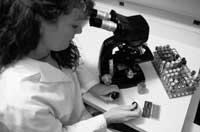Towards overcoming hemophilia

Fibroblasts are connective tissue cells that are fundamental in the formation of fibrous fibers and tissues. At Harvard University, they collected fibroblasts from hemophilia patients and made genetic changes to produce protein (factor VIII) that is responsible for blood clotting. Subsequently, the cells were reintroduced to patients and a follow-up of 12 months was carried out. According to the results, the research was successful and, in addition, the patients had no side effects. Therefore, hemophilia may be the first curable pathology by gene therapy.
Hemophilia is a disease that occurs when a blood clotting component does not work properly. When the failure is found in factor VIII, type A hemophilia is considered (85% of cases). When the lack is in factor IX, however, it is called type B hemophilia. Hemophilia patients have clotting problems and expel blood longer than normal. To avoid clotting they need to take the missing factor.
Buletina
Bidali zure helbide elektronikoa eta jaso asteroko buletina zure sarrera-ontzian











